Leadership and Management for Service Industries : Assignment Sample
VerifiedAdded on 2021/02/20
|8
|1530
|23
AI Summary
Contribute Materials
Your contribution can guide someone’s learning journey. Share your
documents today.
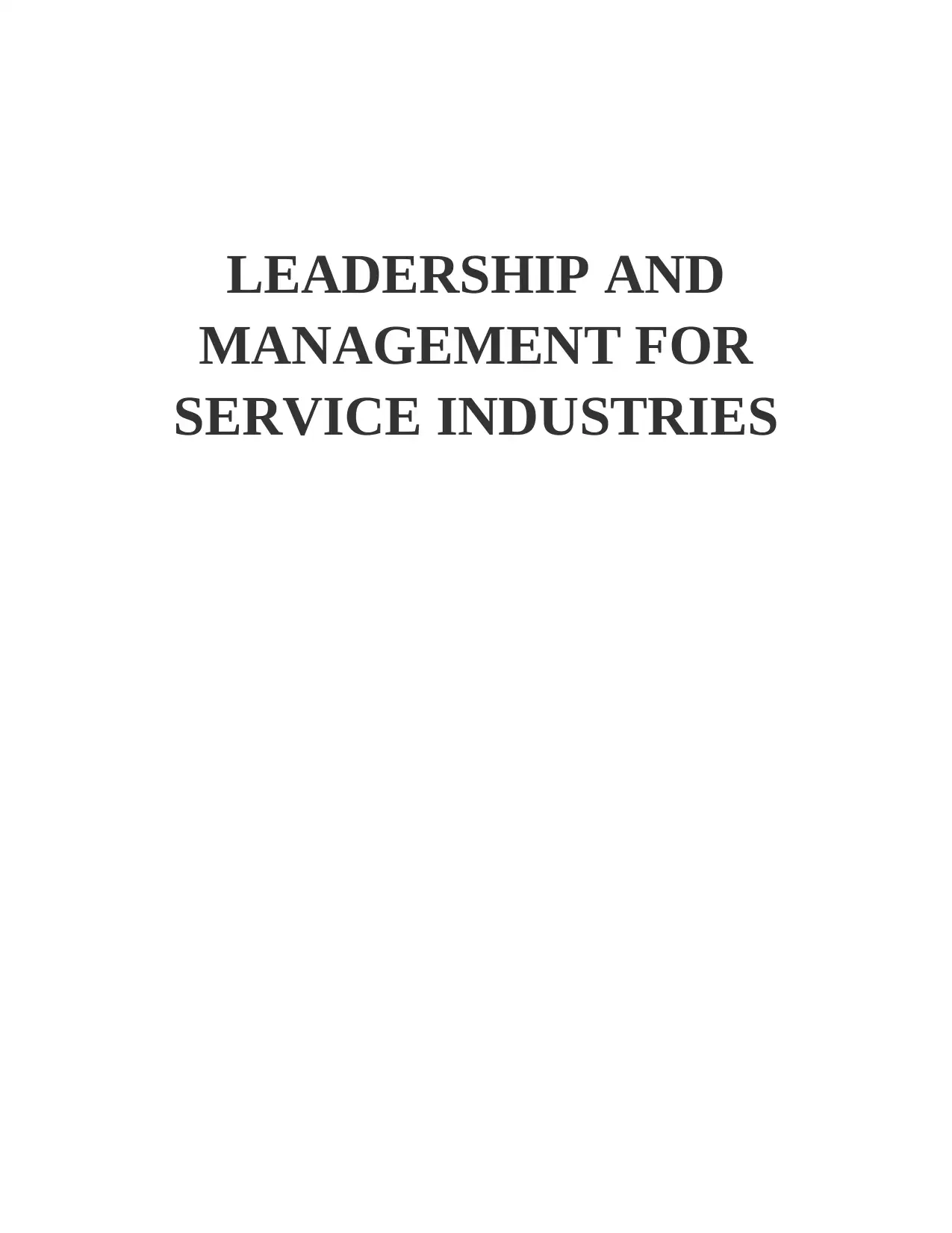
LEADERSHIP AND
MANAGEMENT FOR
SERVICE INDUSTRIES
MANAGEMENT FOR
SERVICE INDUSTRIES
Secure Best Marks with AI Grader
Need help grading? Try our AI Grader for instant feedback on your assignments.
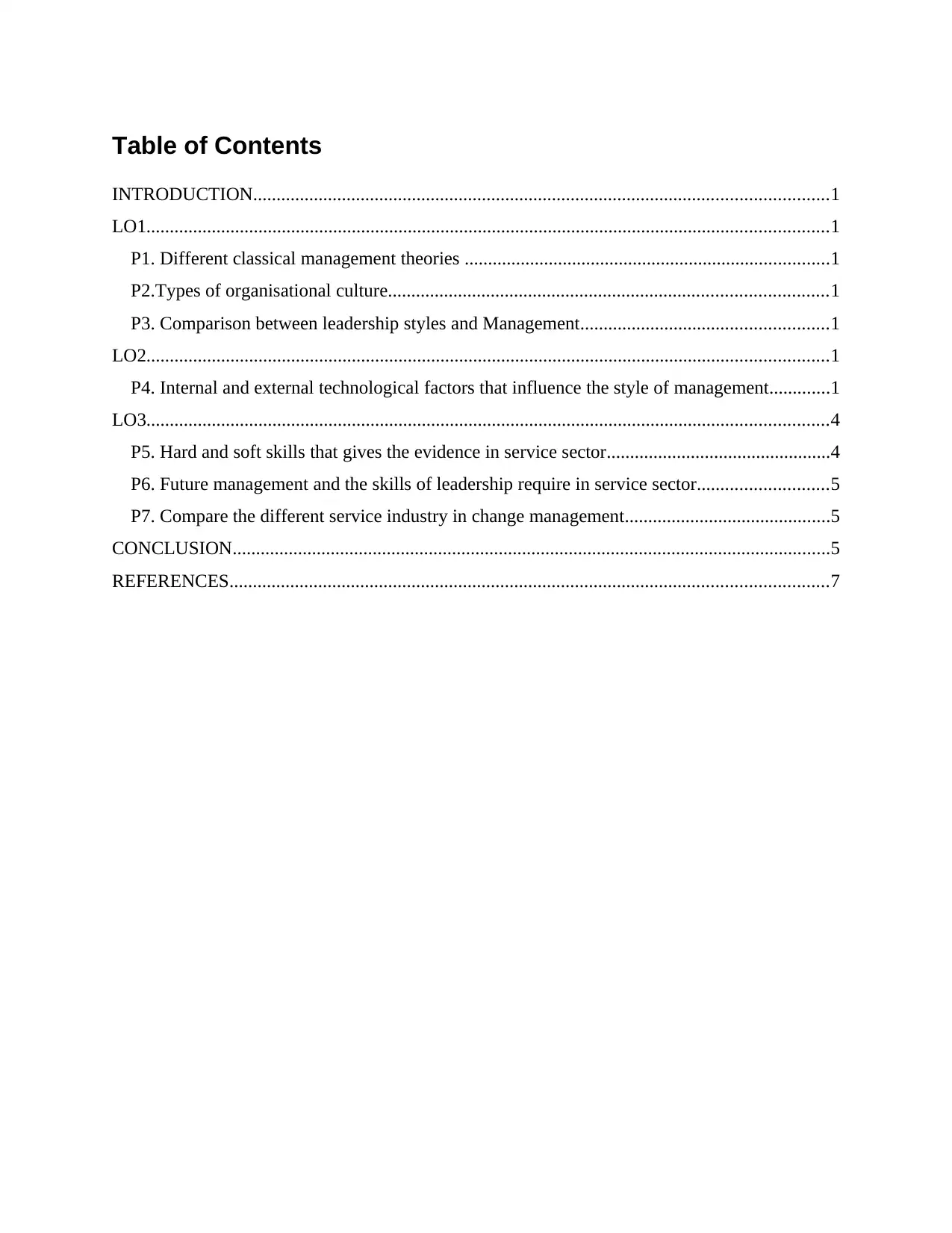
Table of Contents
INTRODUCTION...........................................................................................................................1
LO1..................................................................................................................................................1
P1. Different classical management theories ..............................................................................1
P2.Types of organisational culture..............................................................................................1
P3. Comparison between leadership styles and Management.....................................................1
LO2..................................................................................................................................................1
P4. Internal and external technological factors that influence the style of management.............1
LO3..................................................................................................................................................4
P5. Hard and soft skills that gives the evidence in service sector................................................4
P6. Future management and the skills of leadership require in service sector............................5
P7. Compare the different service industry in change management............................................5
CONCLUSION................................................................................................................................5
REFERENCES................................................................................................................................7
INTRODUCTION...........................................................................................................................1
LO1..................................................................................................................................................1
P1. Different classical management theories ..............................................................................1
P2.Types of organisational culture..............................................................................................1
P3. Comparison between leadership styles and Management.....................................................1
LO2..................................................................................................................................................1
P4. Internal and external technological factors that influence the style of management.............1
LO3..................................................................................................................................................4
P5. Hard and soft skills that gives the evidence in service sector................................................4
P6. Future management and the skills of leadership require in service sector............................5
P7. Compare the different service industry in change management............................................5
CONCLUSION................................................................................................................................5
REFERENCES................................................................................................................................7
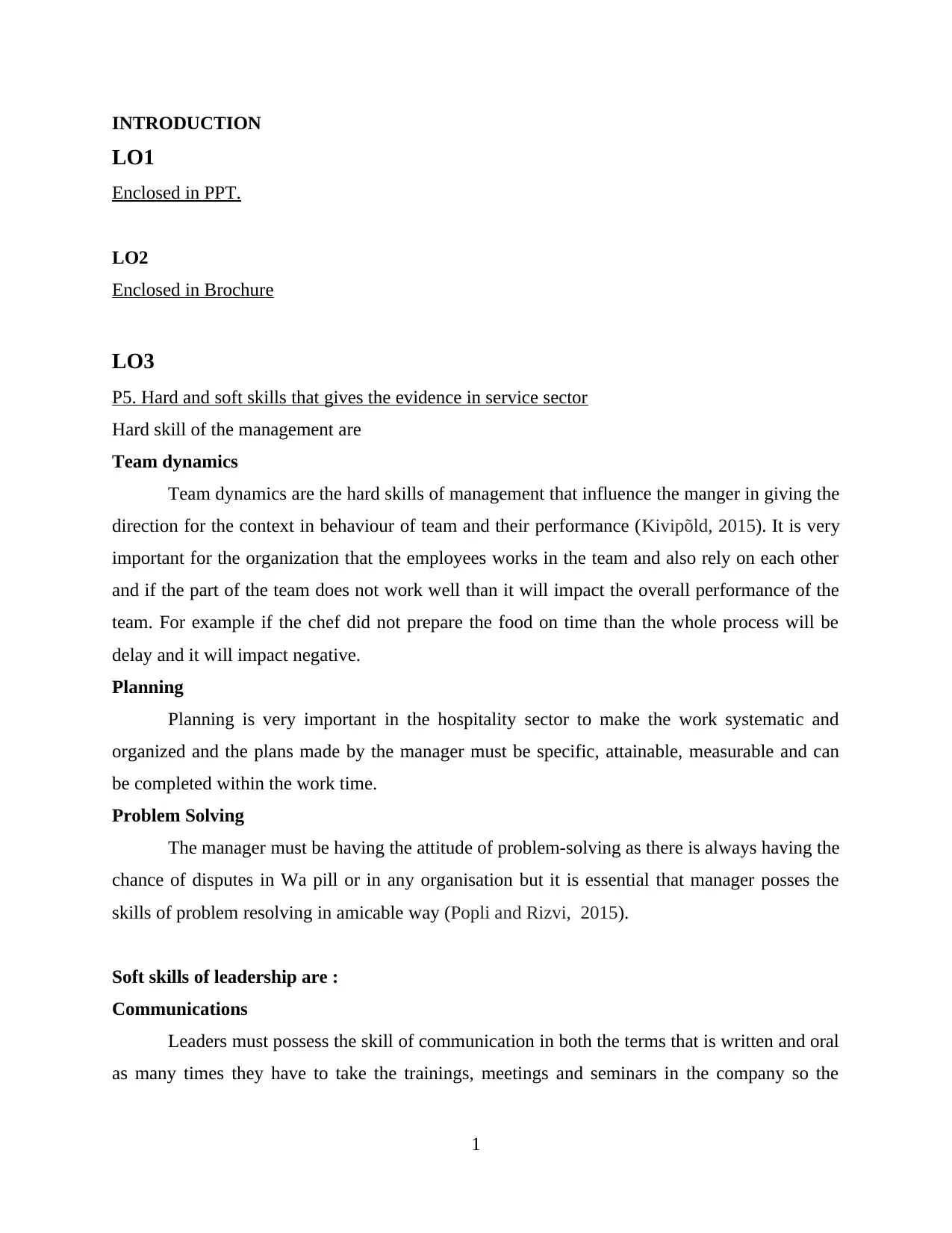
INTRODUCTION
LO1
Enclosed in PPT.
LO2
Enclosed in Brochure
LO3
P5. Hard and soft skills that gives the evidence in service sector
Hard skill of the management are
Team dynamics
Team dynamics are the hard skills of management that influence the manger in giving the
direction for the context in behaviour of team and their performance (Kivipõld, 2015). It is very
important for the organization that the employees works in the team and also rely on each other
and if the part of the team does not work well than it will impact the overall performance of the
team. For example if the chef did not prepare the food on time than the whole process will be
delay and it will impact negative.
Planning
Planning is very important in the hospitality sector to make the work systematic and
organized and the plans made by the manager must be specific, attainable, measurable and can
be completed within the work time.
Problem Solving
The manager must be having the attitude of problem-solving as there is always having the
chance of disputes in Wa pill or in any organisation but it is essential that manager posses the
skills of problem resolving in amicable way (Popli and Rizvi, 2015).
Soft skills of leadership are :
Communications
Leaders must possess the skill of communication in both the terms that is written and oral
as many times they have to take the trainings, meetings and seminars in the company so the
1
LO1
Enclosed in PPT.
LO2
Enclosed in Brochure
LO3
P5. Hard and soft skills that gives the evidence in service sector
Hard skill of the management are
Team dynamics
Team dynamics are the hard skills of management that influence the manger in giving the
direction for the context in behaviour of team and their performance (Kivipõld, 2015). It is very
important for the organization that the employees works in the team and also rely on each other
and if the part of the team does not work well than it will impact the overall performance of the
team. For example if the chef did not prepare the food on time than the whole process will be
delay and it will impact negative.
Planning
Planning is very important in the hospitality sector to make the work systematic and
organized and the plans made by the manager must be specific, attainable, measurable and can
be completed within the work time.
Problem Solving
The manager must be having the attitude of problem-solving as there is always having the
chance of disputes in Wa pill or in any organisation but it is essential that manager posses the
skills of problem resolving in amicable way (Popli and Rizvi, 2015).
Soft skills of leadership are :
Communications
Leaders must possess the skill of communication in both the terms that is written and oral
as many times they have to take the trainings, meetings and seminars in the company so the
1
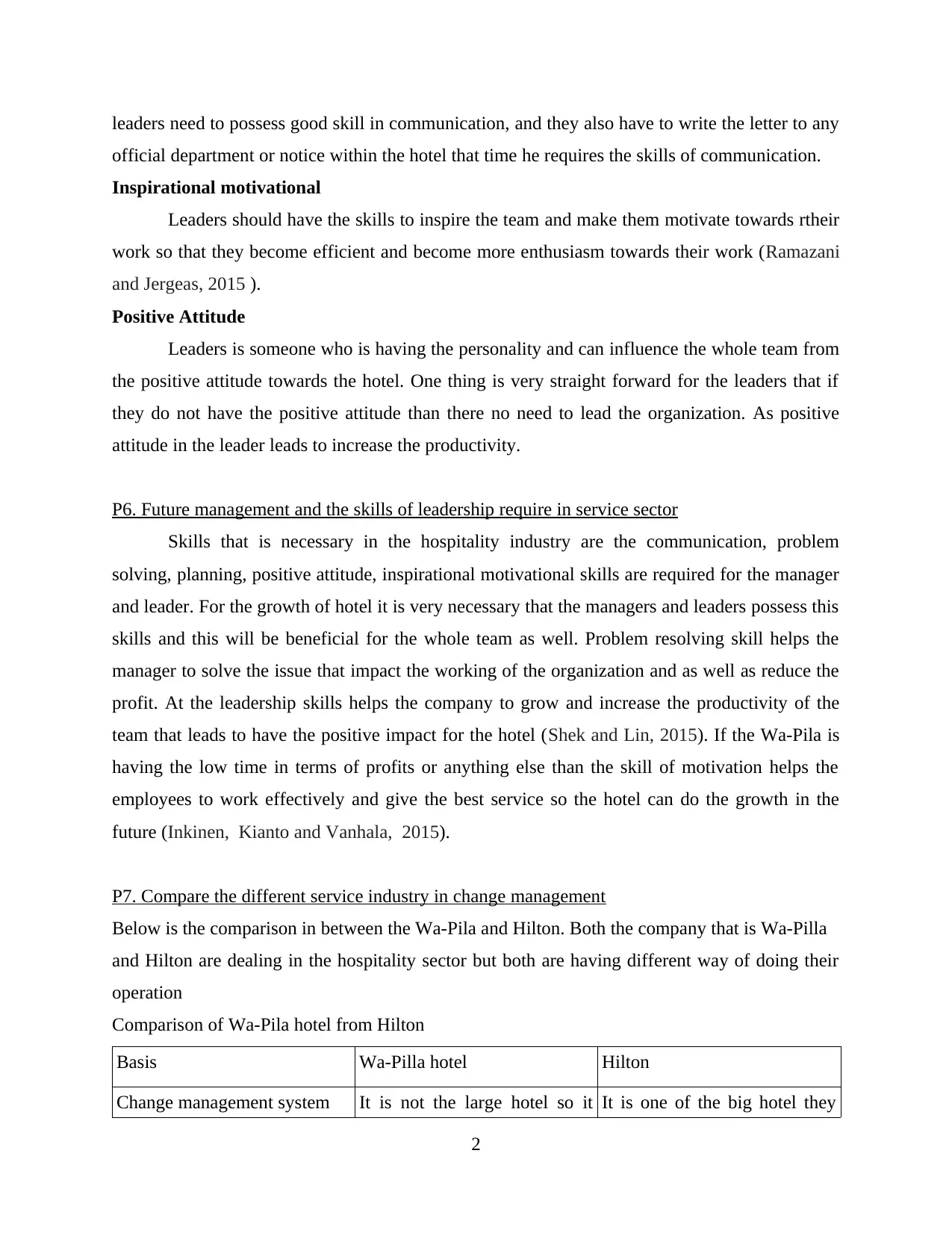
leaders need to possess good skill in communication, and they also have to write the letter to any
official department or notice within the hotel that time he requires the skills of communication.
Inspirational motivational
Leaders should have the skills to inspire the team and make them motivate towards rtheir
work so that they become efficient and become more enthusiasm towards their work (Ramazani
and Jergeas, 2015 ).
Positive Attitude
Leaders is someone who is having the personality and can influence the whole team from
the positive attitude towards the hotel. One thing is very straight forward for the leaders that if
they do not have the positive attitude than there no need to lead the organization. As positive
attitude in the leader leads to increase the productivity.
P6. Future management and the skills of leadership require in service sector
Skills that is necessary in the hospitality industry are the communication, problem
solving, planning, positive attitude, inspirational motivational skills are required for the manager
and leader. For the growth of hotel it is very necessary that the managers and leaders possess this
skills and this will be beneficial for the whole team as well. Problem resolving skill helps the
manager to solve the issue that impact the working of the organization and as well as reduce the
profit. At the leadership skills helps the company to grow and increase the productivity of the
team that leads to have the positive impact for the hotel (Shek and Lin, 2015). If the Wa-Pila is
having the low time in terms of profits or anything else than the skill of motivation helps the
employees to work effectively and give the best service so the hotel can do the growth in the
future (Inkinen, Kianto and Vanhala, 2015).
P7. Compare the different service industry in change management
Below is the comparison in between the Wa-Pila and Hilton. Both the company that is Wa-Pilla
and Hilton are dealing in the hospitality sector but both are having different way of doing their
operation
Comparison of Wa-Pila hotel from Hilton
Basis Wa-Pilla hotel Hilton
Change management system It is not the large hotel so it It is one of the big hotel they
2
official department or notice within the hotel that time he requires the skills of communication.
Inspirational motivational
Leaders should have the skills to inspire the team and make them motivate towards rtheir
work so that they become efficient and become more enthusiasm towards their work (Ramazani
and Jergeas, 2015 ).
Positive Attitude
Leaders is someone who is having the personality and can influence the whole team from
the positive attitude towards the hotel. One thing is very straight forward for the leaders that if
they do not have the positive attitude than there no need to lead the organization. As positive
attitude in the leader leads to increase the productivity.
P6. Future management and the skills of leadership require in service sector
Skills that is necessary in the hospitality industry are the communication, problem
solving, planning, positive attitude, inspirational motivational skills are required for the manager
and leader. For the growth of hotel it is very necessary that the managers and leaders possess this
skills and this will be beneficial for the whole team as well. Problem resolving skill helps the
manager to solve the issue that impact the working of the organization and as well as reduce the
profit. At the leadership skills helps the company to grow and increase the productivity of the
team that leads to have the positive impact for the hotel (Shek and Lin, 2015). If the Wa-Pila is
having the low time in terms of profits or anything else than the skill of motivation helps the
employees to work effectively and give the best service so the hotel can do the growth in the
future (Inkinen, Kianto and Vanhala, 2015).
P7. Compare the different service industry in change management
Below is the comparison in between the Wa-Pila and Hilton. Both the company that is Wa-Pilla
and Hilton are dealing in the hospitality sector but both are having different way of doing their
operation
Comparison of Wa-Pila hotel from Hilton
Basis Wa-Pilla hotel Hilton
Change management system It is not the large hotel so it It is one of the big hotel they
2
Secure Best Marks with AI Grader
Need help grading? Try our AI Grader for instant feedback on your assignments.
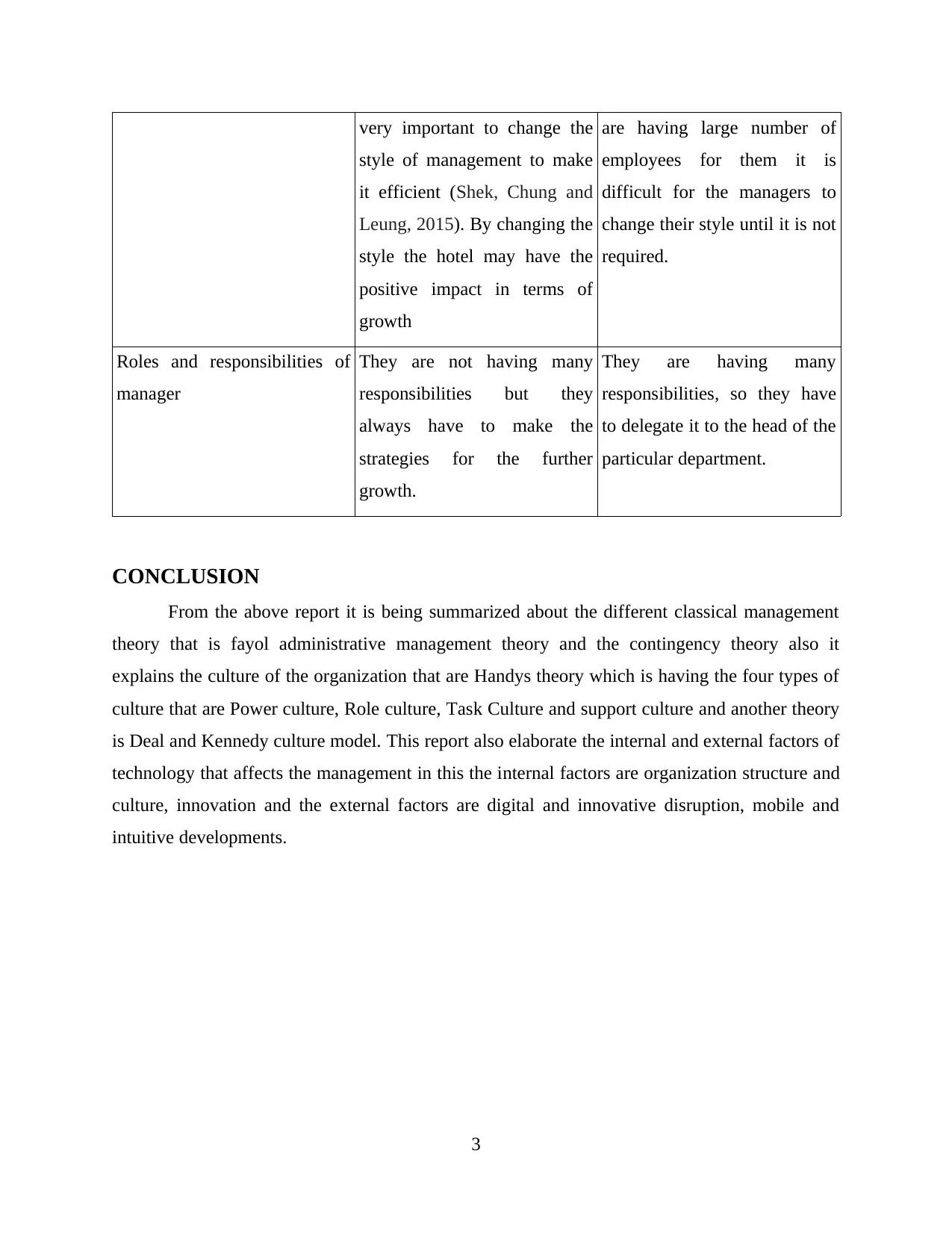
very important to change the
style of management to make
it efficient (Shek, Chung and
Leung, 2015). By changing the
style the hotel may have the
positive impact in terms of
growth
are having large number of
employees for them it is
difficult for the managers to
change their style until it is not
required.
Roles and responsibilities of
manager
They are not having many
responsibilities but they
always have to make the
strategies for the further
growth.
They are having many
responsibilities, so they have
to delegate it to the head of the
particular department.
CONCLUSION
From the above report it is being summarized about the different classical management
theory that is fayol administrative management theory and the contingency theory also it
explains the culture of the organization that are Handys theory which is having the four types of
culture that are Power culture, Role culture, Task Culture and support culture and another theory
is Deal and Kennedy culture model. This report also elaborate the internal and external factors of
technology that affects the management in this the internal factors are organization structure and
culture, innovation and the external factors are digital and innovative disruption, mobile and
intuitive developments.
3
style of management to make
it efficient (Shek, Chung and
Leung, 2015). By changing the
style the hotel may have the
positive impact in terms of
growth
are having large number of
employees for them it is
difficult for the managers to
change their style until it is not
required.
Roles and responsibilities of
manager
They are not having many
responsibilities but they
always have to make the
strategies for the further
growth.
They are having many
responsibilities, so they have
to delegate it to the head of the
particular department.
CONCLUSION
From the above report it is being summarized about the different classical management
theory that is fayol administrative management theory and the contingency theory also it
explains the culture of the organization that are Handys theory which is having the four types of
culture that are Power culture, Role culture, Task Culture and support culture and another theory
is Deal and Kennedy culture model. This report also elaborate the internal and external factors of
technology that affects the management in this the internal factors are organization structure and
culture, innovation and the external factors are digital and innovative disruption, mobile and
intuitive developments.
3
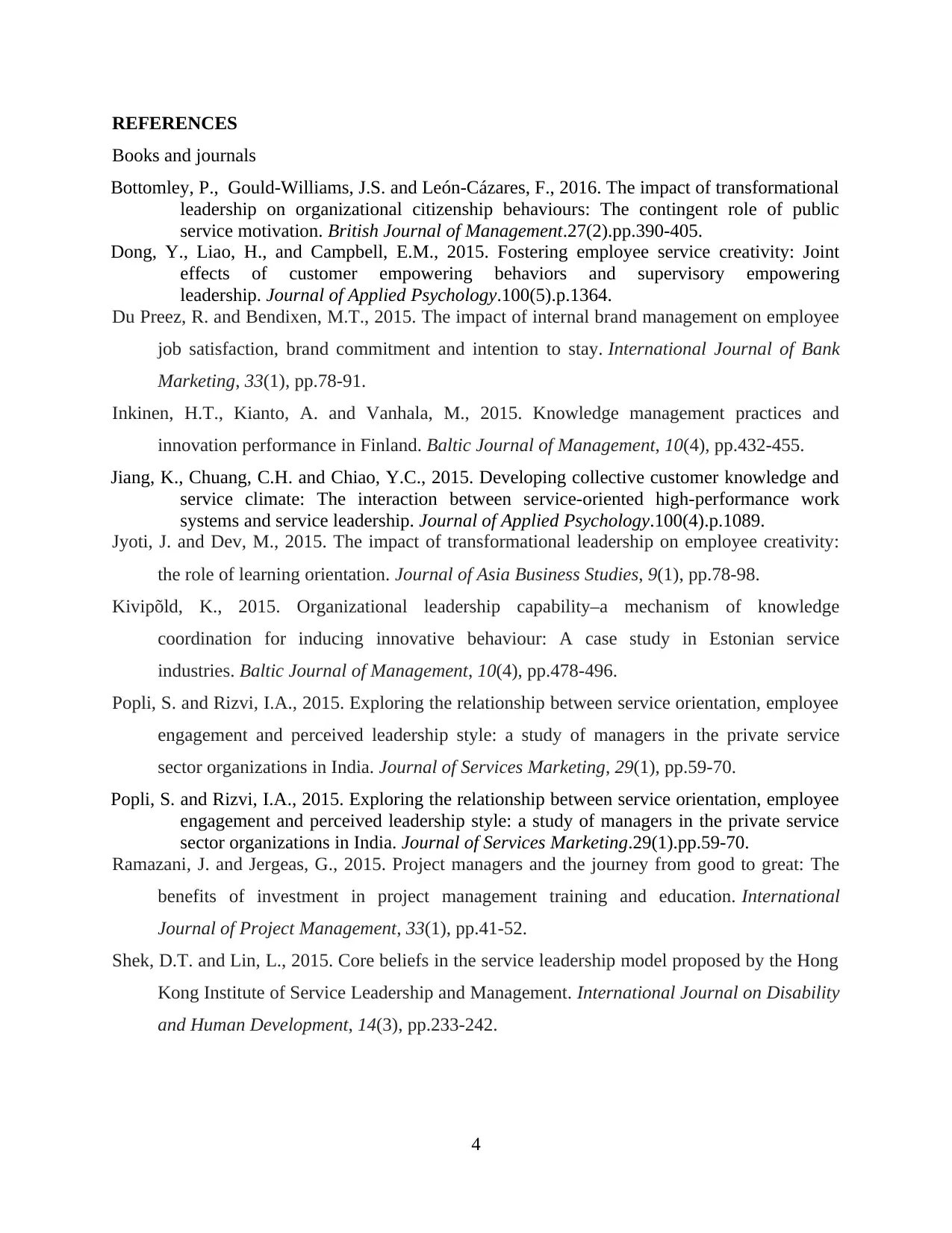
REFERENCES
Books and journals
Bottomley, P., Gould‐Williams, J.S. and León‐Cázares, F., 2016. The impact of transformational
leadership on organizational citizenship behaviours: The contingent role of public
service motivation. British Journal of Management.27(2).pp.390-405.
Dong, Y., Liao, H., and Campbell, E.M., 2015. Fostering employee service creativity: Joint
effects of customer empowering behaviors and supervisory empowering
leadership. Journal of Applied Psychology.100(5).p.1364.
Du Preez, R. and Bendixen, M.T., 2015. The impact of internal brand management on employee
job satisfaction, brand commitment and intention to stay. International Journal of Bank
Marketing, 33(1), pp.78-91.
Inkinen, H.T., Kianto, A. and Vanhala, M., 2015. Knowledge management practices and
innovation performance in Finland. Baltic Journal of Management, 10(4), pp.432-455.
Jiang, K., Chuang, C.H. and Chiao, Y.C., 2015. Developing collective customer knowledge and
service climate: The interaction between service-oriented high-performance work
systems and service leadership. Journal of Applied Psychology.100(4).p.1089.
Jyoti, J. and Dev, M., 2015. The impact of transformational leadership on employee creativity:
the role of learning orientation. Journal of Asia Business Studies, 9(1), pp.78-98.
Kivipõld, K., 2015. Organizational leadership capability–a mechanism of knowledge
coordination for inducing innovative behaviour: A case study in Estonian service
industries. Baltic Journal of Management, 10(4), pp.478-496.
Popli, S. and Rizvi, I.A., 2015. Exploring the relationship between service orientation, employee
engagement and perceived leadership style: a study of managers in the private service
sector organizations in India. Journal of Services Marketing, 29(1), pp.59-70.
Popli, S. and Rizvi, I.A., 2015. Exploring the relationship between service orientation, employee
engagement and perceived leadership style: a study of managers in the private service
sector organizations in India. Journal of Services Marketing.29(1).pp.59-70.
Ramazani, J. and Jergeas, G., 2015. Project managers and the journey from good to great: The
benefits of investment in project management training and education. International
Journal of Project Management, 33(1), pp.41-52.
Shek, D.T. and Lin, L., 2015. Core beliefs in the service leadership model proposed by the Hong
Kong Institute of Service Leadership and Management. International Journal on Disability
and Human Development, 14(3), pp.233-242.
4
Books and journals
Bottomley, P., Gould‐Williams, J.S. and León‐Cázares, F., 2016. The impact of transformational
leadership on organizational citizenship behaviours: The contingent role of public
service motivation. British Journal of Management.27(2).pp.390-405.
Dong, Y., Liao, H., and Campbell, E.M., 2015. Fostering employee service creativity: Joint
effects of customer empowering behaviors and supervisory empowering
leadership. Journal of Applied Psychology.100(5).p.1364.
Du Preez, R. and Bendixen, M.T., 2015. The impact of internal brand management on employee
job satisfaction, brand commitment and intention to stay. International Journal of Bank
Marketing, 33(1), pp.78-91.
Inkinen, H.T., Kianto, A. and Vanhala, M., 2015. Knowledge management practices and
innovation performance in Finland. Baltic Journal of Management, 10(4), pp.432-455.
Jiang, K., Chuang, C.H. and Chiao, Y.C., 2015. Developing collective customer knowledge and
service climate: The interaction between service-oriented high-performance work
systems and service leadership. Journal of Applied Psychology.100(4).p.1089.
Jyoti, J. and Dev, M., 2015. The impact of transformational leadership on employee creativity:
the role of learning orientation. Journal of Asia Business Studies, 9(1), pp.78-98.
Kivipõld, K., 2015. Organizational leadership capability–a mechanism of knowledge
coordination for inducing innovative behaviour: A case study in Estonian service
industries. Baltic Journal of Management, 10(4), pp.478-496.
Popli, S. and Rizvi, I.A., 2015. Exploring the relationship between service orientation, employee
engagement and perceived leadership style: a study of managers in the private service
sector organizations in India. Journal of Services Marketing, 29(1), pp.59-70.
Popli, S. and Rizvi, I.A., 2015. Exploring the relationship between service orientation, employee
engagement and perceived leadership style: a study of managers in the private service
sector organizations in India. Journal of Services Marketing.29(1).pp.59-70.
Ramazani, J. and Jergeas, G., 2015. Project managers and the journey from good to great: The
benefits of investment in project management training and education. International
Journal of Project Management, 33(1), pp.41-52.
Shek, D.T. and Lin, L., 2015. Core beliefs in the service leadership model proposed by the Hong
Kong Institute of Service Leadership and Management. International Journal on Disability
and Human Development, 14(3), pp.233-242.
4
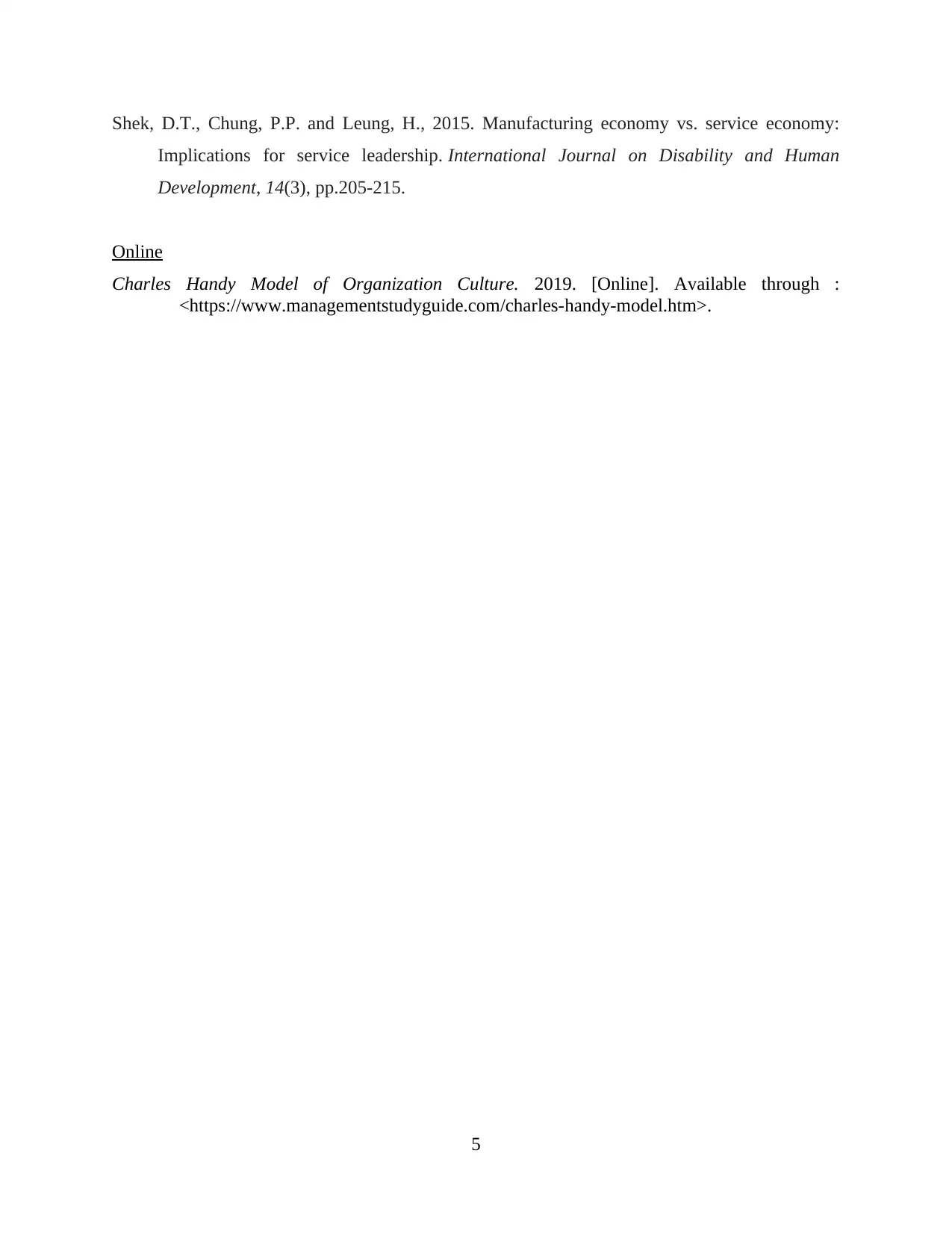
Shek, D.T., Chung, P.P. and Leung, H., 2015. Manufacturing economy vs. service economy:
Implications for service leadership. International Journal on Disability and Human
Development, 14(3), pp.205-215.
Online
Charles Handy Model of Organization Culture. 2019. [Online]. Available through :
<https://www.managementstudyguide.com/charles-handy-model.htm>.
5
Implications for service leadership. International Journal on Disability and Human
Development, 14(3), pp.205-215.
Online
Charles Handy Model of Organization Culture. 2019. [Online]. Available through :
<https://www.managementstudyguide.com/charles-handy-model.htm>.
5
Paraphrase This Document
Need a fresh take? Get an instant paraphrase of this document with our AI Paraphraser

1 out of 8
Related Documents
Your All-in-One AI-Powered Toolkit for Academic Success.
+13062052269
info@desklib.com
Available 24*7 on WhatsApp / Email
![[object Object]](/_next/static/media/star-bottom.7253800d.svg)
Unlock your academic potential
© 2024 | Zucol Services PVT LTD | All rights reserved.




